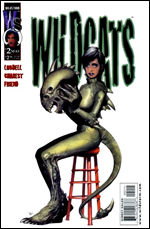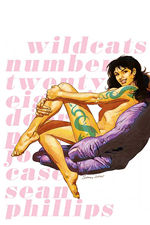>> Comment: Appointments With Disappointment
>> Comment: Accentuate The Positive?
More...

Writers: Joe Casey, Scott Lobdell
Artists: Sean Phillips, Travis Charest, Richard Friend, Bryan Hitch, Paul Neary, Carlos D'Anda, Scott Benefiel, Steve Dillon
DC Wildstorm
During it's initial fifty-issue run, WILDC.A.T.S volume one spoke to the core demographic of superhero obsessives. A product of the Great Upheaval - Marvel's great and good jumping ship to create their own company - Image proved that though the creators' hearts were in the right place, their creativity had sidled away while nobody was looking. That Jim Lee and company had left behind one money-grubbing corporation to create their own merely proves the old adage that the road to hell is paved with good intentions.
WILDC.A.T.S was X-MEN redux; it had all the important elements minus forty years of consumer identification and a corporate budget, the major difference being that Jim Lee got paid instead of Marvel. It didn't stop the title from being a poor imitation, with its own enigmatic loner (Wolverine/Grifter), a boy scout leader (Cyclops/Spartan), a femme fatale (Psylocke/Zealot) and a bulky genius (Beast/Maul). However, it did have Jim Lee's art and later Alan Moore, Chris Claremont and James Robinson on wordsmith duties. Historically, it retains a position of interest.
 Gifted with the revamping of this staid super-team in WILDCATS volume two, Scott Lobdell was teamed with perfectionist wunderkid Travis Charest and handed a good dose of creative freedom. Previously, Alan Moore had tried to bring an honest end to the 'CATS. The first volume dealt with a secretive war between two alien races; the evil Daemonite and the goody-two-shoes Kherubim.
Gifted with the revamping of this staid super-team in WILDCATS volume two, Scott Lobdell was teamed with perfectionist wunderkid Travis Charest and handed a good dose of creative freedom. Previously, Alan Moore had tried to bring an honest end to the 'CATS. The first volume dealt with a secretive war between two alien races; the evil Daemonite and the goody-two-shoes Kherubim.
In a masterstroke of patented Moore cynicism, the title's purpose was eradicated. The team discovered that while they had been fighting here on Earth, the time delay between Earth and the two races' home worlds meant the actual war had ended millennia ago. So the stage was set for volume two, where the premise now was that they no longer had a premise. The idea of superheroes with no raison d'être was one that both Scott Lobdell and Joe Casey were to latch on to.
However, the relaunch of volume two didn't exactly run without a hitch. Switching to a bimonthly schedule to keep up with Travis Charest's beautiful but time-sapping artwork would have been bearable if the writing were of any substance. Scott Lobdell's constant cock-tease of characterisation would make anybody impatient even if they didn't have to wait two months for it. His loose Marvel-style plots allowed more room for interpretation than was required, and a generally interesting idea was rendered blank by audience-lulling delays and constant fill-in artwork.
As with so many other promising projects, Lobdell's pre-press interviews sold the series as something it very barely approached being. The idea that the heroes were trying to get on with their lives was there, but the book shot itself in the foot with its slow roll-out and its over-reliance on the clichés of the genre, such as super-villains. When he was taken off the book it was a mercy killing, leaving a breach for Joe Casey and Sean Phillips to step into.
Phillips bore enough of a basic similarity to Charest that his transfer didn't cause as much uproar as other fill-in artists had. More than that, Phillips pencilled and inked on a monthly basis, later handling cover duties as well. Phillips was previously Mr Vertigo - most renowned for his long-stint on HELLBLAZER with Paul Jenkins - and a surprise appointment for such a high-profile superbook.
 Casey made his name on various third-tier Marvel titles. His work on CABLE was fine, but outshone by the glorious Kirbyesque artwork of Jose Ladronn. His DEATHLOK reboot was unfortunately snuffed out after barely a year. His standout project was the X-MEN: CHILDREN OF THE ATOM mini. Dogged by delays and art team changes, it was an intelligent and beautifully constructed retelling of the X-MEN's birth, set in modern day.
Casey made his name on various third-tier Marvel titles. His work on CABLE was fine, but outshone by the glorious Kirbyesque artwork of Jose Ladronn. His DEATHLOK reboot was unfortunately snuffed out after barely a year. His standout project was the X-MEN: CHILDREN OF THE ATOM mini. Dogged by delays and art team changes, it was an intelligent and beautifully constructed retelling of the X-MEN's birth, set in modern day.
The premise for Casey and Phillips' run was simple; there was no premise. No boogieman to scare from under the bed, no invasion fleet to ward off, no supervillains left to throw back in jail. The biggest challenge for each member of this team was not facing the supervillain-of-the-month, but facing life without a supervillain-of-the-month.
Casey's immediate problems of tying up old Lobdell plot-threads and setting up the pins for his run are covered by the second volume two trade, VICIOUS CIRCLES. That this trade begins with the eradication of the team's Professor X-esque mentor, Emp, just goes to show that Casey wasn't playing. That it incensed long-time fans was probably not so good for sales, but a cynic might suggest that it was upsetting the right people.
While this initial arc does feature a rather superfluous supervillain appearance, it does flesh-out the wonderful love/hate relationship between Emp and his arch-enemy Kenyan. That Kenyan would rather blow his own brains out than finally kill Emp and end a hundred years of cat-and-mouse is a masterstroke. Indeed Emp's line "What are you... In love with me?" hints at a fascinating world of possibility.
The rest of this trade reintroduces old characters (Casey's long-time fictional co-conspirator Maxine Manchester, aka Ladytron), sets up shop for the rest of the volume (Spartan ceding control of a vast corporation from his old master, Emp) and changes some characters forever (the hallucinatory tale of Void's life and rebirth minus a human soul).
It's with the long-form serial-killer story SERIAL BOXES that Casey hit high-gear. Its slow-building tension and lack of overt superheroics gives it an edge that too few mainstream titles have. That two heroes are seemingly mutilated and another is rendered inert just goes to further prove Casey's balls are big and brass.
Sparing as much space for characterisation as for over-the-top action led the title to be dubbed "ChattyCats" by Casey's compadre, Joe Kelly. Although the title's decompressed narrative stylings may not have been that far from what Scott Lobdell was attempting, it's the consistency of the art team and the monthly schedule that held the piece together.
 Sean Phillips pencilled and inked every issue minus two fill-ins by Steve Dillon. However, the artistic musical chairs did spread to the covers for half the series, beginning with Travis Charest, then JG Jones, then a return for creator Jim Lee, ending with Sean Phillips. Sean's covers are a collage of painting, modern design and classic line work. They stand out next to the unimaginative shtick that fills the rest of the comics shelf.
Sean Phillips pencilled and inked every issue minus two fill-ins by Steve Dillon. However, the artistic musical chairs did spread to the covers for half the series, beginning with Travis Charest, then JG Jones, then a return for creator Jim Lee, ending with Sean Phillips. Sean's covers are a collage of painting, modern design and classic line work. They stand out next to the unimaginative shtick that fills the rest of the comics shelf.
More than anything, it's Joe Casey's distaste for the staid "rules" of the super-hero genre and how he breaks them that stands out. There are no song-and-dance unveils of world-changing plot-twists. Characters die, change, leave, come back and disintegrate from month-to-month with little to no allusion that this title was ever a home to superheroes. For example, a gay character is introduced and is not used as a soapbox for discussion of homosexual rights in the modern day. In fact, he's portrayed as a rather sleazy character - renting roach-infested motel rooms for illicit sex with pizza delivery boys.
This second volume could almost be Noir's story. He is introduced in the first issue and we witness his slow integration into the non-team and finally his betrayal of his friends. This is the closest Casey's run ever comes to a real super-villain (outside of Scott's creation Kenyan), while the rest is a hodgepodge of good guys gone bad, bad guys gone good and psychos gone crazy.
Casey and Phillips' run is not without its problems. The slow pacing is less of a problem with a monthly title, but it did drag over the course of the SERIAL BOXES arc. Casey also tends to be less than subtle in both characterisation and subtext. Grifter suffers the worst under his pen, most probably because he gets the most panel-time. His random outbursts and hair-trigger anxiety stand at odds with past characterisation.
The writer's fascination with the sex/violence dynamic begins to grate as the series draws to a close. It's wonderful that these topics are being discussed, but it'd ring more true if they weren't loudhailered every time. In the impending third volume, when the book will become a mature readers title, these aspects will presumably be even more to the fore.
In the post-premise superhero book, an artist like Phillips, who can effortlessly switch from long fight sequences to a quiet chat over coffee, is the perfect compliment to a writer as character-driven as Casey. In the end, perhaps what WILDCATS best exemplifies is that it's not the premise that makes a superhero book, but the right marriage of writer and artist.

This article is Ideological Freeware. The author grants permission for its reproduction and redistribution by private individuals on condition that the author and source of the article are clearly shown, no charge is made, and the whole article is reproduced intact, including this notice.


